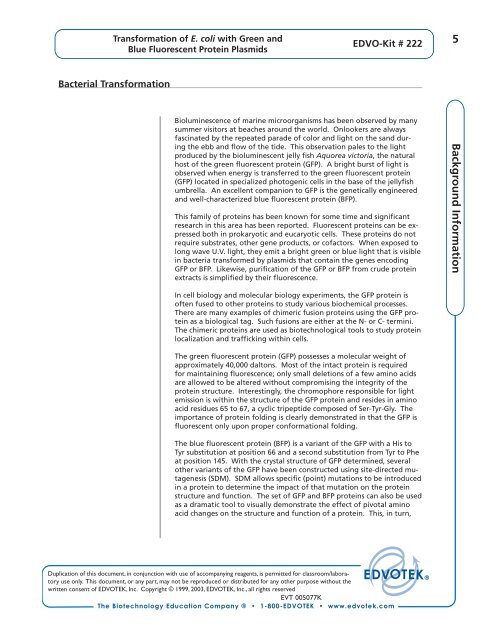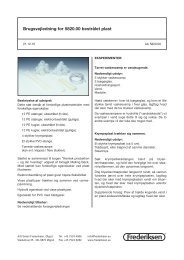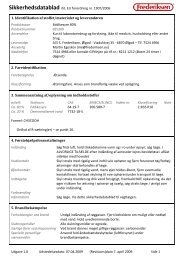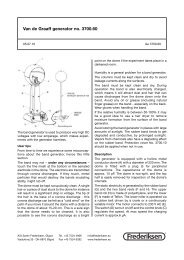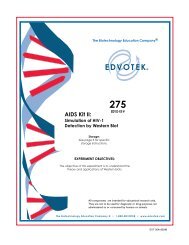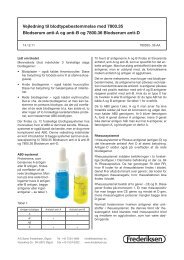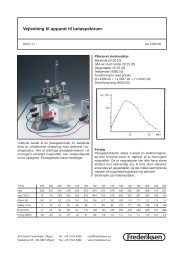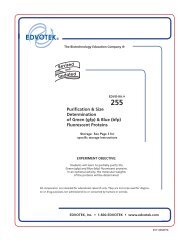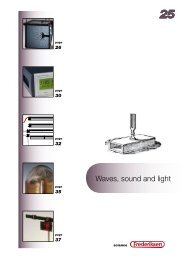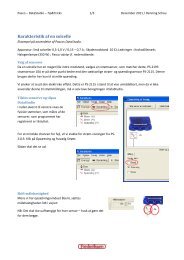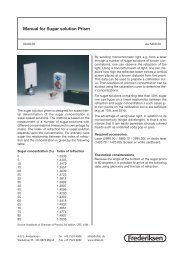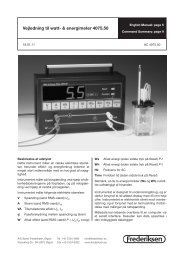Transformation of E. coli with Green and Blue ... - Frederiksen
Transformation of E. coli with Green and Blue ... - Frederiksen
Transformation of E. coli with Green and Blue ... - Frederiksen
You also want an ePaper? Increase the reach of your titles
YUMPU automatically turns print PDFs into web optimized ePapers that Google loves.
<strong>Transformation</strong> <strong>of</strong> E. <strong>coli</strong> <strong>with</strong> <strong>Green</strong> <strong>and</strong><strong>Blue</strong> Fluorescent Protein PlasmidsEDVO-Kit # 222Bacterial <strong>Transformation</strong>Bioluminescence <strong>of</strong> marine microorganisms has been observed by manysummer visitors at beaches around the world. Onlookers are alwaysfascinated by the repeated parade <strong>of</strong> color <strong>and</strong> light on the s<strong>and</strong> duringthe ebb <strong>and</strong> flow <strong>of</strong> the tide. This observation pales to the lightproduced by the bioluminescent jelly fish Aquorea victoria, the naturalhost <strong>of</strong> the green fluorescent protein (GFP). A bright burst <strong>of</strong> light isobserved when energy is transferred to the green fluorescent protein(GFP) located in specialized photogenic cells in the base <strong>of</strong> the jellyfishumbrella. An excellent companion to GFP is the genetically engineered<strong>and</strong> well-characterized blue fluorescent protein (BFP).This family <strong>of</strong> proteins has been known for some time <strong>and</strong> significantresearch in this area has been reported. Fluorescent proteins can be expressedboth in prokaryotic <strong>and</strong> eucaryotic cells. These proteins do notrequire substrates, other gene products, or c<strong>of</strong>actors. When exposed tolong wave U.V. light, they emit a bright green or blue light that is visiblein bacteria transformed by plasmids that contain the genes encodingGFP or BFP. Likewise, purification <strong>of</strong> the GFP or BFP from crude proteinextracts is simplified by their fluorescence.Background InformationIn cell biology <strong>and</strong> molecular biology experiments, the GFP protein is<strong>of</strong>ten fused to other proteins to study various biochemical processes.There are many examples <strong>of</strong> chimeric fusion proteins using the GFP proteinas a biological tag. Such fusions are either at the N- or C- termini.The chimeric proteins are used as biotechnological tools to study proteinlocalization <strong>and</strong> trafficking <strong>with</strong>in cells.The green fluorescent protein (GFP) possesses a molecular weight <strong>of</strong>approximately 40,000 daltons. Most <strong>of</strong> the intact protein is requiredfor maintaining fluorescence; only small deletions <strong>of</strong> a few amino acidsare allowed to be altered <strong>with</strong>out compromising the integrity <strong>of</strong> theprotein structure. Interestingly, the chromophore responsible for lightemission is <strong>with</strong>in the structure <strong>of</strong> the GFP protein <strong>and</strong> resides in aminoacid residues 65 to 67, a cyclic tripeptide composed <strong>of</strong> Ser-Tyr-Gly. Theimportance <strong>of</strong> protein folding is clearly demonstrated in that the GFP isfluorescent only upon proper conformational folding.The blue fluorescent protein (BFP) is a variant <strong>of</strong> the GFP <strong>with</strong> a His toTyr substitution at position 66 <strong>and</strong> a second substitution from Tyr to Pheat position 145. With the crystal structure <strong>of</strong> GFP determined, severalother variants <strong>of</strong> the GFP have been constructed using site-directed mutagenesis(SDM). SDM allows specific (point) mutations to be introducedin a protein to determine the impact <strong>of</strong> that mutation on the proteinstructure <strong>and</strong> function. The set <strong>of</strong> GFP <strong>and</strong> BFP proteins can also be usedas a dramatic tool to visually demonstrate the effect <strong>of</strong> pivotal aminoacid changes on the structure <strong>and</strong> function <strong>of</strong> a protein. This, in turn,Duplication <strong>of</strong> this document, in conjunction <strong>with</strong> use <strong>of</strong> accompanying reagents, is permitted for classroom/laboratoryuse only. This document, or any part, may not be reproduced or distributed for any other purpose <strong>with</strong>out thewritten consent <strong>of</strong> EDVOTEK, Inc. Copyright © 1999, 2003, EDVOTEK, Inc., all rights reservedEVT 005077KThe Biotechnology Education Company ® • 1-800-EDVOTEK • www.edvotek.com


